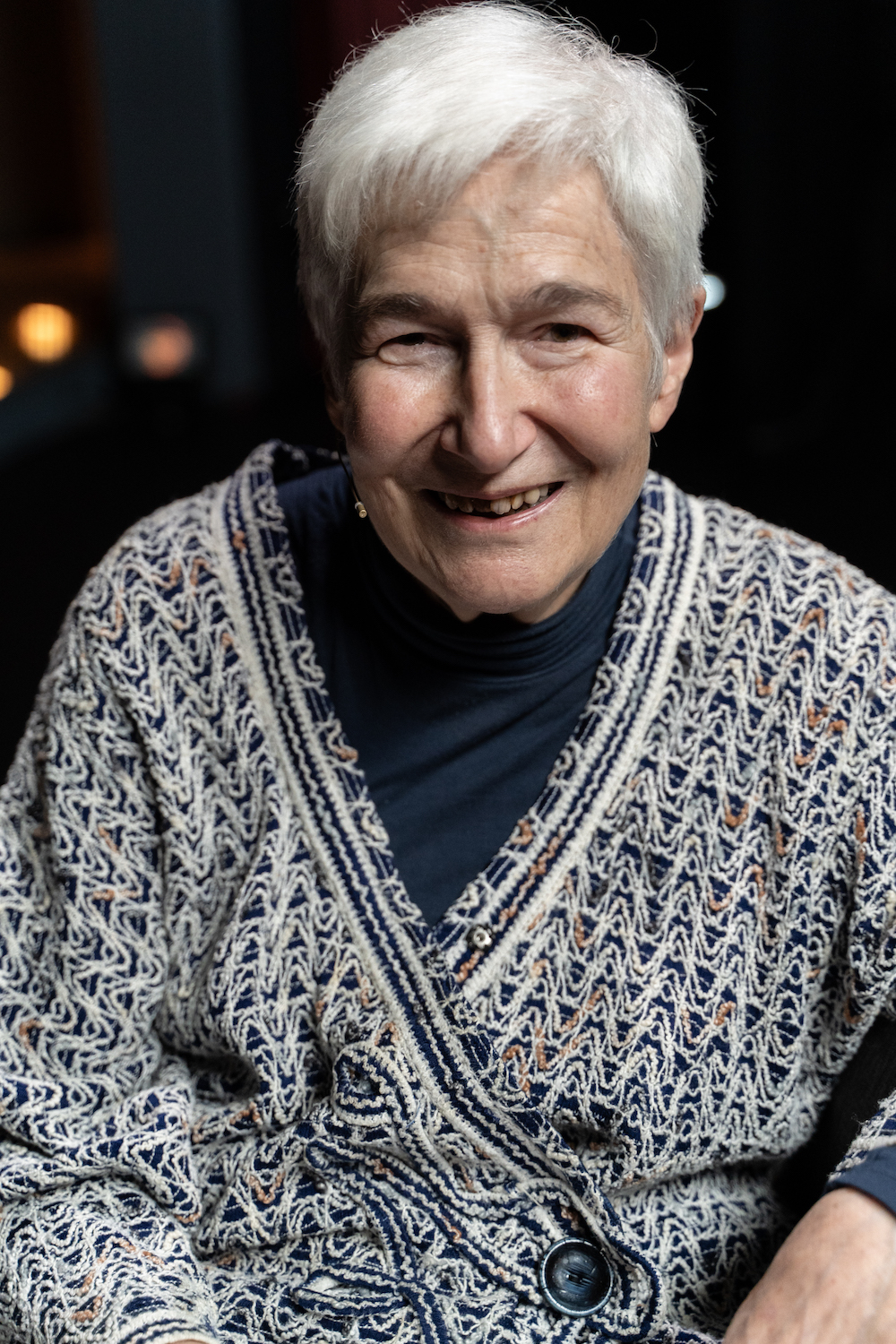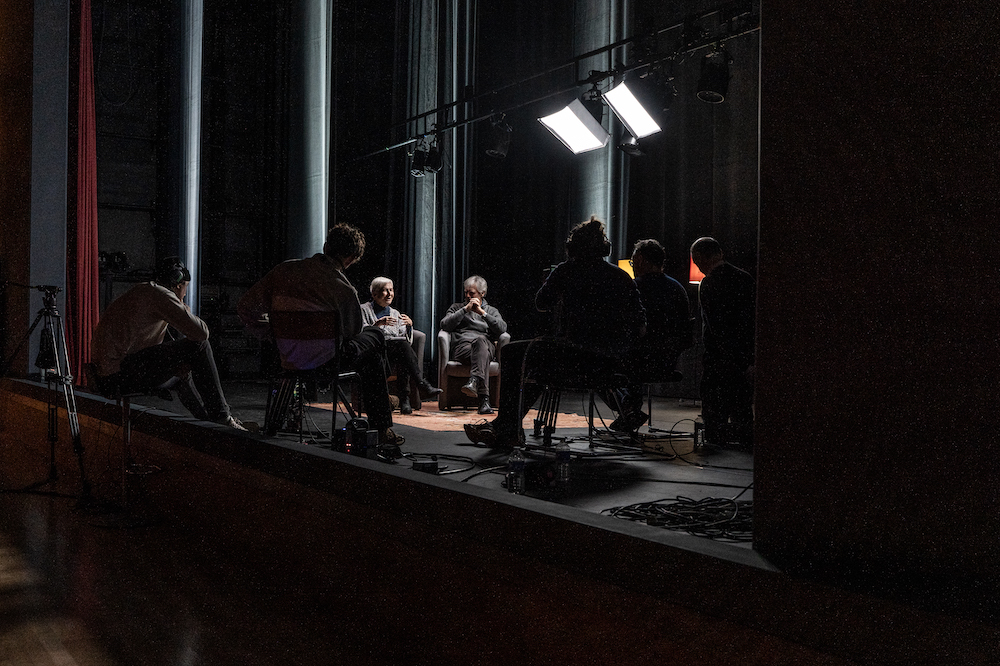Sociologist and Urban planner (France) who contributed to the round table 03: Map the Imagination.
Anne Querrien is a French sociologist and urban planner. Her research focuses on city and social housing policy, but also on school as a “space to be liberated,” or gender or sexual duality.
Leader of the March 22 movement in Nanterre and Paris in 1968, she was secretary general of CERFI (Centre d’Etudes, de Recherches et de Formation Institutionelles) created by Félix Guattari in the 1970s, where she became a friend of Guy Hocquenghem, among others.
She is a contributor to the journals “Annales de la recherche urbaine”, “Chimères” and “Multitudes”.
— an interview by Antoine Le Bos, Screenwriter and Artistic Director of Le Groupe Ouest, recorded at Les Champs Libres (Rennes) in December 2023 in the framework of the serie “What stories for our time?”.

Anne Querrien
« Grasps a sugar cube: it takes something from reality, then we plunge it into another environment »
The concept to give more taste.
A concept is like sugar tongs, it grasps a sugar cube… in the days we used sugar cubes. So, it takes something from reality, then we plunge it into another environment, made up of other elements, to create something different, to give flavour.
« The rhizome forms this way going from one to another and not from a centrality. »
The rhizome to create, in network & horizontality.
The idea of a rhizome is closely related to an important aspect of psychoanalysis which is the non-hierarchical association of ideas. It’s quite close, it’s a botanical image. The rhizome is particular in that we can replicate the plant, using any part of it without needing the seed. The rhizome is the opposite of a root for those who are a bit rigid, because in fact rhizome plants also have roots.
For me, it’s essentially agricultural in a way. It’s the fact of transplanting like we do with rice or multiplying potatoes, using the sprouts on the potato itself. The rhizome forms this way going from one to another and not from a centrality.
There’s the famous fable by La Fontaine, called the “The Oak and the Reed”. The reed rhizome resists wind way better than the oak with its sturdy roots – the common belief. Meaning that, for example, because I’m trained in rhizomaticity.
I love grass, I observe grass everywhere. And I realize that everybody, when talking about plants, at the moment only consider trees. Grass isn’t a noble plant, it seems. We continue to think of plants in a hierarchical way. The oak being highly considered in Europe, is almost identified as a sovereignty.

« No teleology. Life! »
Proliferation as a process of creation
Deleuzian thinking is non-sovereign thinking. Guattari, who joined forces with Deleuze at some point, was very interested in proliferation. No teleology. Life! Unlike many of our friends, who are Deleuze and Guattari followers and currently preoccupied with collapse… No, not collapse, a proliferation, which will continue, take different forms, etc.
« By closing oneself off in an existential territory we can’t really create. »
Deterritorialization to go beyond the existential territory
The concept I like the most, which ties into all of this, is deterritorialization. I find it absolutely fascinating. And it relates to the idea of flow. Meaning that in the world around us, including this seemingly rigid materiality, electrons are flowing. There is flow everywhere, even in the marble beneath our feet.
My psychotherapist friends say that when they’re with a patient, the patient is generally deterritorialized in almost the most trivial sense of the word. The therapy’s job is to reterritorialize them to restore, what in Guattari’s mapping, he called the existential territory. The idea was that therapy should build something beyond this existential territory, enabling communication with other human productions, to create something else, particularly in artistic and creative worlds. By closing oneself off in an existential territory we can’t really create. We can feel better, maybe.
For Guattari and Deleuze, and also in my opinion, deterritorialization is in physical matter and is conveyed by the human mind, initially via our unconscious. For schizophrenics, for the demented, for those non-reterritorialized in psychiatric hospitals and the like, who haven’t exasperated people enough to be reterritorialized, this deterritorialization is very sensitive.

« Moving within an elliptical space. »
Mapping to study contact with each other
The notion of mapping arrived somewhat accidentally. Guattari had ties with Deligny. Deligny went to La Borde at a time, when he could no longer stay in the Cévennes in the 1960s. I saw him in La Borde in 1965. And Deligny, in order to live with children, not just autistic in the usual sense, but non-verbal – for reasons Americans would say are pathological, physical – to live with these young people as humans he had to break away from the Lacanian hypothesis stating that what characterizes humans is language.
Deligny literally inherited an 8-year-old boy named Janmari, who’d spin round and round screaming. No institution wanted to keep him except if he was tied down. His mother entrusted him to Deligny. Things weren’t doing well at La Borde, Deligny was there when he arrived, Deligny took him to the Cévennes, to his home. He started a small community with someone named Jacques Lin, who is still there, who’d been an industrial draftsman, not an artist. So Deligny takes on Jacques Lin, who couldn’t bear Janmari, and told him: “Since you’re a draughtsman, you can draw all Janmari’s movements, you follow him, and every time he screams and spins around, you draw a circle on his tracking map.” Jacques Lin started on these maps.
At first, when it was… with the network, it became a bit systematic, the maps aren’t so interesting. Initially they realized that Janmari moved within an elliptical space revolving around Deligny and Jacques Lin’s residence. Establishing a human contact with them, other than just having meals together. And even when he disappeared, it was within these ellipses, in which also he found water sources. The maps showed surprising results, in that the paths made by Janmari and other children treated by Deligny… There were the functional paths taking them to where they ate. And Deligny named customary the organization of the daily functional space, saying that these children – this joins territoriality – these children needed an extremely repetitive space, within which they created other paths, which he called “wander lines.” We had no idea what these wander lines were used for, where they went, but they were part of the overall space.

« By superimposing the maps, discovering the structure. »
The layer as map reading tool
Félix and Deleuze were intrigued by these maps. They were the base of all the Rhizome texts which always makes me wonder why they so ardently argued that maps and layers weren’t the same thing. Because Deligny had thought of superimposing the maps, which were done on tracing paper. And he saw it traced the spaces I mentioned earlier, by superimposing the maps. And they also made a map per child, and by superimposing the maps, they discovered the structure. For me, there’s no opposition in the text between the traced layers and the maps, because the tracing layer is actually a tool for reading the map.
« Reality in flows, the imaginary world in existential territory, the symbolical and the machine. »
A map of the world
I was fascinated by Félix’s text called Schizoanalytic Cartographies. It’s a form of mapping, in my opinion, which he used in his therapies, but in fact it’s mapping the world. There are four poles: there’s the flow in physical matter – matter has flows, we spoke about that earlier. There are the existential territories, which are a result of deterritorialization then reterritorialization of this matter.
And via this deterritorialization then reterritorialization, within the existential territories, we produce what he called immaterial universes which are all the abstract civilizational productions, generated by humans – which are multiple and not unique as we were taught at school. In which there’s plenty to explore…
And furthermore, there’s a fourth… pure Guattarians would say not – but I believe it corresponds to Lacan’s three poles: reality in flows, the imaginary world in existential territory – this is where we come back to stories – and the symbolical, which is everything we produce, such as music, maths, philosophy and all that. To which Félix adds what he calls the phylo-machinic, meaning that humanity and matter combined have produced a whole series of material and technical alliances: machines, which in genealogy are somewhat like animal species, and it’s the intersection between the immaterial universes, meaning abstract diagrams and the flows produced by the machines.

« In life, there are always these heterogenous encounters in the real world, precisely in concomitance, which will produce something else. »
The machine as a creative power
Guattari’s notion of machine is quite unique. In a book called Psychoanalysis and Transversality, which is a collection of articles that Guattari had published, which were spread through different magazines, there’s a text called Machine and Structure. And in this text, there is the note number 1, where Guattari establishes series with heterogeneous things, which he associates with a third term, which I call a machine.
I find that remarkable, because it gives the machine the capacity to deal with a huge number of situations, from the car to the nuclear power plant, etc. to relationships… Let’s say… Here, at Les Champs Libres, we have a planetarium and an exhibition on palaeontology which will be set up together and for certain visitors, not all, there’ll be a link between these two things which could result in making a film or whatever.
In life, there are always these heterogenous encounters in the real world, precisely in concomitance, which will produce something else, even if it’s just a poetic image, that can be shared around the world. Others will add to this and transform it using other objects. I find that very powerful. And it’s a very simple machine.

« The body without organs is the non-functional emergence of desire. »
The body without organs: a return to the original egg
In Anti-Oedipus and in A Thousand Plateaus, there’s the question of how to make a body without organs. In that a body without organs as smooth as an egg – the egg being the metaphor of production, germination, birth, and all that – how do we rid ourselves of all these functionalities, these organic compounds, to transform into an egg, which will become something else.
There’s a whole concept of becoming, becoming woman, becoming animal, becoming plant also, it’s all in A Thousand Plateaus. It’s a concept coming from Artaud. And Artaud was really schizophrenic. And for schizophrenics, from time to time, they see their bodies or their hands going off elsewhere or they perceive their bodies. As described in Anti-Oedipus: like an egg on which everything slides and nothing sticks. They’re extremely violent sensations that we don’t experience. The body without organs is the non-functional emergence of desire. The Body without Organs is essentially a return to the primal egg.
« In classical music, the ritornello, it’s returning to the theme. That’s what everyone is waiting for. For me, it’s the opposite. »
The ritornello as a reterritorialization
The ritornello, for example, is a bit like reterritorialization. In classical music, the ritornello, I think it’s returning to the theme. That’s what everyone is waiting for. For me, it’s the opposite. I’m always waiting for a new theme. I practically only listen to contemporary music. As soon as I’ve heard it three times, I look for something else. I’m not a good example.
© Photos Brigitte Bouillot
Podcast: Play in new window | Download
